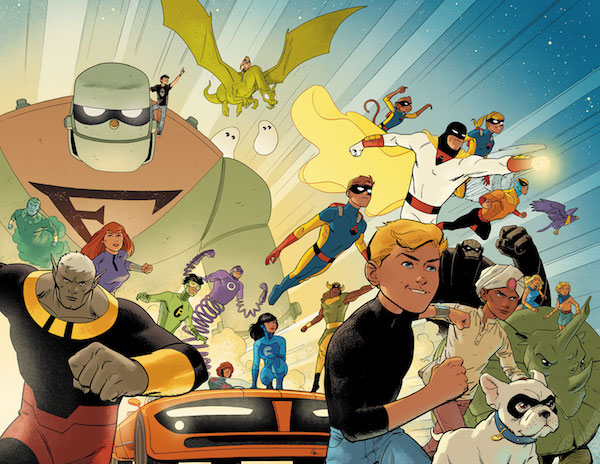
Review: ‘Future Quest’ Vol. 1
Future Quest, vol. 1
Writer: Jeff Parker
Artists: Evan Shaner, Steve Rude and others
DC Comics; $16.99
 DC Comics and Hanna-Barbera share an owner in Warner Bros, and the former has been publishing comics starring the latter’s Scooby-Doo character for years now. Last year, DC began an ambitious—and deeply weird—mini-line of comics starring various Hanna-Barbera characters, four books that I’ve been collectively referring to as the reboot-happy publisher’s “Hanna-Barbereboot.”
DC Comics and Hanna-Barbera share an owner in Warner Bros, and the former has been publishing comics starring the latter’s Scooby-Doo character for years now. Last year, DC began an ambitious—and deeply weird—mini-line of comics starring various Hanna-Barbera characters, four books that I’ve been collectively referring to as the reboot-happy publisher’s “Hanna-Barbereboot.”
While Scooby Apocalypse, Wacky Raceland, The Flinstones, and Future Quest were all high-concept new takes on children’s cartoon characters from the mid-to-late 1960s, the only one of the four that is actually all-ages and something that isn’t just appropriate for a young reader, but also potentially enjoyable, is Future Quest. And it is the one comic that is based on a half-dozen of Hanna-Barbera’s old action/adventure cartoons.
ADVERTISEMENT
ADVERTISEMENT
Put another way, the comic based on the cartoons meant for slightly older, more sophisticated children of the sixties turned out to be the source of the only Hanna-Barbereboot book for young readers. It is also, perhaps not coincidentally, head and shoulders (and torso) better than the rest of the line (The decidedly adult Flinstones has its virtues, but is very much an acquired taste, and it can’t compete visually with Future Quest).
The high concept here, originally conceived by the late Darwyn Cooke and brought to fruition by writer/artist Jeff Parker and a handful of some of the best action/adventure genre cartoonists available, is a familiar one. It amounts to little more than imagining that the stars of Jonny Quest, Birdman, and Frankenstein Jr. and The Impossibles all exist in the same shared universe, even if they are separated from some characters by the vast gulf of space (Space Ghost, The Herculoids) or time (Mightor, Dino Boy).
Using Jonny Quest as a sort of tonal baseline, and then fitting the other characters to it (which, in the cases of Frankenstein Jr. and The Impossibles, means making the characters far less cartoony in design), Parker has created a big, cosmic threat in the form of a mysterious planet-destroying and -assimilating creature that threatens various points in time and space. As the creature nears modern-day Earth, Team Quest and special agents like Birdman try to figure it out and stop it, while their foes try to figure it out and master it for their own nefarious purposes.
Through the portals it creates come things like Space Ghost’s ship and sidekicks, Mightor’s enchanted club (which gives us a new, modern age Mightor) and one of the Herculoids. It’s shared universe crossover comics 101, really, of the sort that DC has been publishing more or less constantly for decades now, but here made fresh and exciting by the bizarre mix of characters, none of whom have appeared in a comic book in any form in…well, years (DC did do a Space Ghost comic in 2005, and Jonny and his pals have appeared in comics, but most of these guys are new to the medium). Fully realized and as old as or older than most of Marvel’s superheroes, the cast takes on the feel of a “lost” world of superheroes.
ADVERTISEMENT
ADVERTISEMENT
Primary artists Evan Shaner and Steve Rude are among the best comics artists working today and, frankly, it’s a little surprising to see them showing up here on this book, as one might expect them to have more important things to do. But it’s hard to imagine the series working at all without them. They are perfectly suited to distill the original character designs, many of them created all those years ago by the late, great artist Alex Toth, down to their essentials, and to capture and covey the spirit of those creations in a way that the cheap television animation that Hanna-Barbera was notorious for never could.
Similarly, Parker’s script finds the appealing core of each character and dramatizes it, but in a way that is fairly far divorced from the not-very-sophisticated original cartoons, which, to be honest, only the older adult readers will have ever even been too terribly familiar with anyway.
The collection isn’t perfect. Because of the peculiarities of serial publishing, the ongoing narrative is occasionally interrupted by origin stories and solo stories featuring various characters, branded as “Tales From The Void” within. The collection can therefore have a herky-jerky feel to it, as it stops and starts, and the narrative seems to indulge in unnecessary digressions at inopportune moments.
No matter. While it’s not perfect, it’s a heck of a lot closer than many modern superhero comics ever manage, and you’re unlikely to find more accomplished-looking, classic-feeling artwork in any other trade paperback on the shelves at the moment.
About J. Caleb Mozzocco
J. Caleb Mozzocco is a way-too-busy freelance writer who has written about comics for online and print venues for a rather long time now. He currently contributes to Comic Book Resources' Robot 6 blog and ComicsAlliance, and maintains his own daily-ish blog at EveryDayIsLikeWednesday.blogspot.com. He lives in northeast Ohio, where he works as a circulation clerk at a public library by day.
ADVERTISEMENT
ADVERTISEMENT
SLJ Blog Network
Name That LEGO Book Cover! (#53)
Cover Reveal and Q&A: The One and Only Googoosh with Azadeh Westergaard
Fighting Public School Book Bans with the Civil Rights Act
Take Five: Middle Grade Anthologies and Short Story Collections
ADVERTISEMENT








